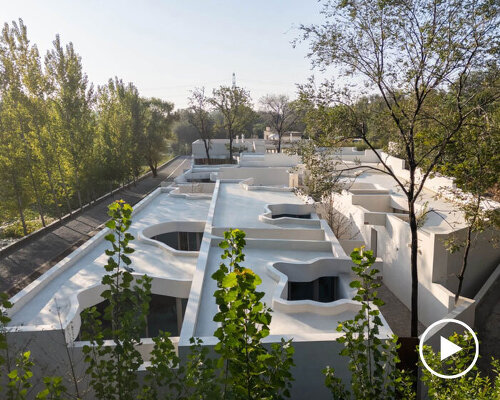Domain Architects’ Hermit Resort Reinterprets Ancient Kiln Forms
Located near the historic Xing Kiln Ruins in Hebei Province, China, Hermit Resort by Domain Architects draws direct inspiration from the site’s archaeological and cultural context. The project responds to its proximity to the 1,500-year-old kiln remains, where the original layout of multiple chambers arranged in a horseshoe formation around a small courtyard remains visible despite centuries of erosion.
The site itself is part of a relocated village, leaving behind fragmented stone walls and traces of settlement on a gentle slope by a stream. Domain Architects approached the project as an opportunity to create a new form of ‘relic,’ a built environment that bridges the present and the ancient, embracing the aesthetic tension between order and decay. The design references the compositional principles of the historic kilns: spatial clustering, partial enclosure, and the interrelationship of architecture and landscape.
Hermit Resort sits near the ancient Xing Kiln Ruins in Hebei Province, China | all images by ZHANG Chao
Cluster of Interwoven Courtyard buildings shapes Hermit Resort
Rather than a singular building, the resort is conceived as a collection of small, single-story structures that form a loose settlement within the terrain. Structural elements such as beams, walls, and courtyards interlace, creating an intentional ambiguity between interior and exterior spaces. Each of the 50 guest rooms includes a private courtyard. The interior spaces semi-enclose the courtyard in a horseshoe configuration, mirroring the geometry of the original kiln sites. This arrangement dissolves the clear distinction between inside and outside, allowing guests to experience the architectural space as an extension of the surrounding landscape.
Materiality and spatial composition emphasize the passage of time and the coexistence of structure and nature. The interplay of light, shadow, and texture changes with weather and time of day, reinforcing the resort’s relationship to its environment. With Hermit Resort, Domain Architects Studio introduces a model of contemporary hospitality that engages directly with historical memory, landscape, and architectural evolution, inviting occupants to inhabit a space suspended between the past and the future.
the resort draws inspiration from the 1,500-year-old kiln chambers found nearby
Domain Architects reinterprets the spatial logic of the historic kilns
each of the 50 guest rooms features its own private courtyard
horseshoe-shaped layouts echo the geometry of ancient firing chambers
architecture and terrain interweave to create a settlement-like composition
courtyards, beams, and walls merge, softening the boundary between inside and out
the resort is conceived as a modern ‘relic’ within a living landscape
a cluster of small, single-story buildings replaces the idea of one central structure
interior spaces semi-enclose the courtyards, recalling the kiln’s horseshoe form
shifting light and shadow animate the resort throughout the day
a pool at the end of the alleyway anchors the resort’s composition
the architecture changes character with the weather and time of day
project info:
name: Hermit Resort
architect: Domain Architects | @domain_architects
lead architect: Xu Xiaomeng
design team: Xu Xiaomeng, Hannah Wang, YANG Jie
location: Xingtai, Hebei, China
photographer: ZHANG Chao
designboom has received this project from our DIY submissions feature, where we welcome our readers to submit their own work for publication. see more project submissions from our readers here.
edited by: christina vergopoulou | designboom
The post cluster of interwoven white courtyard houses reinterprets ancient kilns for resort in china appeared first on designboom | architecture & design magazine.

